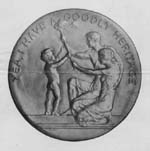

 The boundaries between "eugenic" strategies and mental health and social welfare policies were often diffuse. "Negative eugenics" initiatives included policies that prevented or discouraged "undesirable" people from conceiving children, on the assumption that they would produce offspring like themselves. "Positive eugenics" programs encouraged larger families among those believed to have superior genetic endowment. American eugenicists promoted a "eugenic consciousness" through public education campaigns that stressed the importance of heredity, healthy living, and "good breeding." While urging the adoption of sterilization laws for the "unfit," they promoted public policies that would relieve college-educated parents from the financial burdens of educating and caring for children.
The boundaries between "eugenic" strategies and mental health and social welfare policies were often diffuse. "Negative eugenics" initiatives included policies that prevented or discouraged "undesirable" people from conceiving children, on the assumption that they would produce offspring like themselves. "Positive eugenics" programs encouraged larger families among those believed to have superior genetic endowment. American eugenicists promoted a "eugenic consciousness" through public education campaigns that stressed the importance of heredity, healthy living, and "good breeding." While urging the adoption of sterilization laws for the "unfit," they promoted public policies that would relieve college-educated parents from the financial burdens of educating and caring for children.
 Negative eugenics measures in Vermont followed the lead of other states
in providing institutions for segregation of socially or mentally handicapped persons,
followed by laws permitting sexual sterilization and denial of marriage licenses to those
deemed "mentally unfit" for parenthood. As progressive reformers routinely
attributed social welfare problems to "feebleminded women of child bearing age,"
poor women, particularly unwed mothers, became the primary targets of such measures.
Segregation of the mentally or socially deprived from Vermont communities began in 1915
with the
opening of the Brandon State School for the Feebleminded, which expanded in the
1920s to
include a women's colony for the care, training, and prevention of reproduction of those
committed to state care. In the 1930s, initiatives to parole and discharge inmates replaced
the earlier mandate for segregation, and sexual sterilization became "one tool"
to control the "class of defectives" who otherwise would spend their lives in an
institution.
Negative eugenics measures in Vermont followed the lead of other states
in providing institutions for segregation of socially or mentally handicapped persons,
followed by laws permitting sexual sterilization and denial of marriage licenses to those
deemed "mentally unfit" for parenthood. As progressive reformers routinely
attributed social welfare problems to "feebleminded women of child bearing age,"
poor women, particularly unwed mothers, became the primary targets of such measures.
Segregation of the mentally or socially deprived from Vermont communities began in 1915
with the
opening of the Brandon State School for the Feebleminded, which expanded in the
1920s to
include a women's colony for the care, training, and prevention of reproduction of those
committed to state care. In the 1930s, initiatives to parole and discharge inmates replaced
the earlier mandate for segregation, and sexual sterilization became "one tool"
to control the "class of defectives" who otherwise would spend their lives in an
institution.
| Continue to . . . |